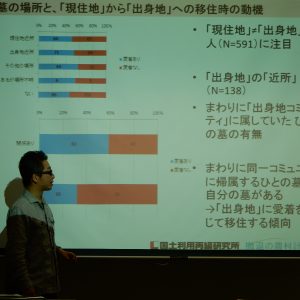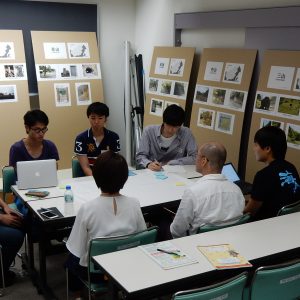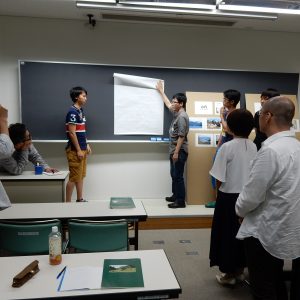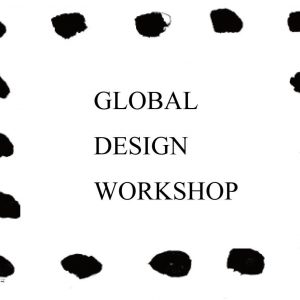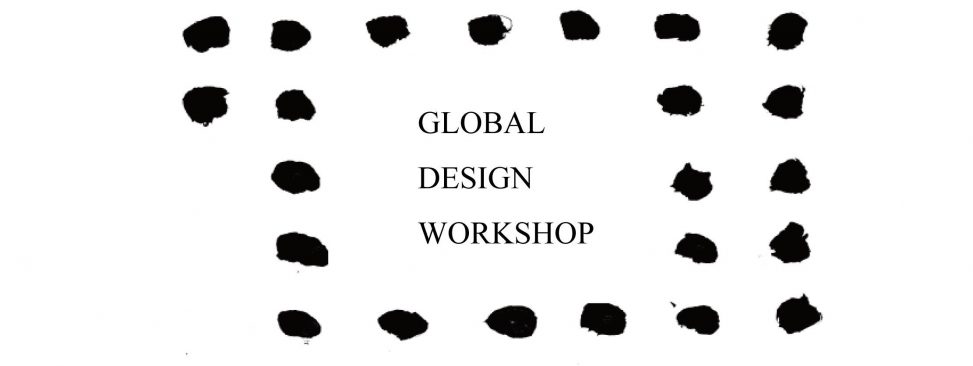
How to Form an Uninhabited but Active Settlement by Using Social ICT
As a consequence of slow depopulation, uninhabited settlements are increasing in Japanese mountainous areas. However, we think that getting uninhabited is different from vanishing of settlement. We can use an uninhabited settlement for primary industries. We may keep an old history of the settlement and make a new one.
This workshop was carried out at the University of Tokyo on July 2, 2016. Our aim was to think a method for forming an uninhabited but active settlement. In addition, we prepared beforehand panels with pictures of some uninhabited settlements.
The workshop was divided into three stages. The first stage was introduction on a depopulated area, uninhabited settlements, using social ICT, the power of ancestors’ graves. In the lecture, Mr. Koyama, one of guest lecturers, shew that historical continuity of an uninhabited settlement can be kept mainly by the former residents. In the second stage, participants discussed how to form an uninhabited but active settlement. From the middle of the activity, they were divided into two groups, and then each group independently discussed it deeply. The third stage was to show the results of their discussions and thinking backward. In addition, main keywords in this stage were virtual reality and a community.
We evaluate their active discussions highly. However, this workshop gave us a point needing improvement. Although I hoped for comprehensive discussions including approaching the essence of settlement before this workshop, they focused only on technical aspect. We have to think an effective devise for the comprehensive discussions.
企画の背景
穏やかではあるが、日本の山間地では過疎化が進行し、無居住化集落が増加している。しかし、「集落の無居住化」と「集落の消滅」が同義とは思えない。無居住化の結果、草木も生えないような荒れ地が広がることはない。少なくとも、その土地を第1次産業に使うことは可能である。集落の歴史を継承し、新たに作り出すことも不可能ではない。
どんなワークショップ?
このワークショップの目的は、無居住化の現状を概観し、無居住化しても「消えない村」の作り方を考えることである。参考のため、「無居住化集落の写真をはり付けた段ボールパネル」を準備し、会場に設置した。
段階1:過疎集落の現状、京丹後市の離村集落(=無居住化集落)とその後(小山氏)、リモートお墓参りアプリ(2014年度のワークショップにて制作)、お墓と帰属意識(齋藤氏)に関する講演が行われた。このワークショップの基礎となる考え方、すなわち、無居住化しても、主として旧住民によって集落の歴史的連続性が維持できることが示された(小山氏)。
段階2:参加者全員で、無居住化しても「消えない村」の作り方について議論した。途中から二つの班に分かれ、さらに議論を深めた。
段階3:議論の結果を共有し、ワークショップ全体のふり返りを行った。
プログラム
| 13:00 - 13:30(30min.) | 趣旨説明・自己紹介、過疎集落の現状の紹介 | |
|---|---|---|
| 13:30 - 14:35(65min.) | 講演「消えない村:京丹後市の離村集落とその後」(小山氏) | |
| 14:35 - 14:50(15min.) | 休憩 | |
| 14:50 - 15:10(20min.) | リモートお墓参りアプリの紹介(ソーシャルICTの活用例) | |
| 15:10 - 15:25(15min.) | 講演「お墓と帰属意識」(齋藤氏) | |
| 15:25 - 16:20(55min.) | 全員での議論 | |
| 16:20 - 16:50(30min.) | 二班に分かれての議論 | |
| 16:50 - 17:05(15min.) | 議論結果の共有 | |
| 17:05 - 17:15(10min.) | ワークショップ全体のふり返り |
ワークショップの成果
議論の結果、無居住化しても「消えない村」の作り方に関する着眼点を得ることができた。集落のバーチャルリアリティー、若者による記録、高齢者による意味づけ、地元の参加、都市住民による更新、外部からの評価による誇りの再建、ドローン、離散後のコミュニティーの持続、表面化していないシンボル、ソーシャルICTへの参加に関する階層構造、アクセス権、実体験とのリンク、草刈りでアクセス権アップグレードなど。
ふり返り
議論自体は活発であり、大いに評価している。主催側は集落の本質を含めた総合的な議論を期待していたが、「ソーシャルICTの活用を考える」という副題に引っ張られたせいか、狭い範囲(技術面)に限定されてしまった。議論の時間を増やしても、結果は同じであったと考えている。総合的な議論を促進するための仕掛け(例:話題の拡散防止)を考案する必要がある。なお、議論の雰囲気づくりには貢献したと思われるが、写真をはった段ボールパネルはあまり注目されていなかった。
| アイテム | 無居住化集落の写真をはり付けた段ボールパネル、模造紙、付せん紙、筆記用具など |
|
|---|---|---|
| 開催日時 | 2016.7.2(土) 13:00 - 17:15 |
|
| 場所 | 東京大学農学部7号館B:231/232教室 |
|
| 参加者・人数 | 7名 |
|
| 講師/ファシリテーター | 小山元孝(NPO法人TEAM旦波) |
原稿執筆:林直樹


